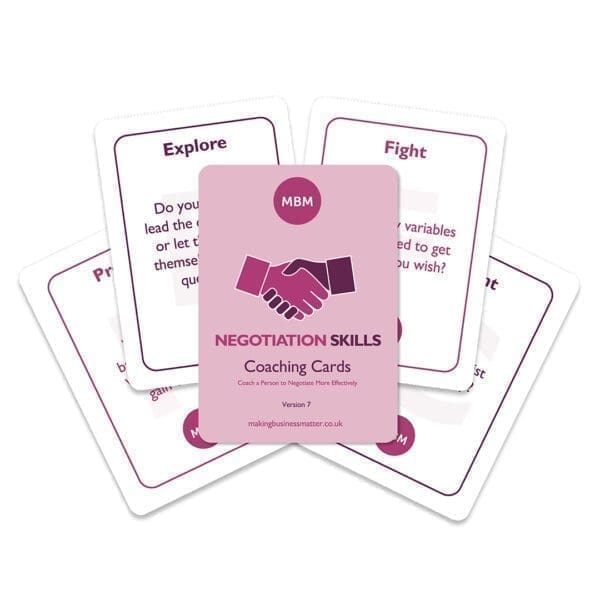The Relationship Matters as Much as the Transaction
Principled negotiation happens when people on both sides of the table have common ‘principle interests,’ and seek to either build or maintain a rapport and settle on the best possible outcome.
‘PN’ takes work and active listening, but the benefits are that both parties reach compromises and agreements, while avoiding disputes and arguments, and achieve co-creation, Habit # 6 in Stephen R. Covey’s 7 Habits of Highly Effective People.
Well, this article looks at how you can bring order to your negotiations by applying principled negotiation in different situations, from selling to customers to resolving internal conflicts.
What Are the 4 Principles of Principled Negotiation?
Various experts have written extensively about this. Here’s an overview:

Principle #1: Address the Problems, Not the People
When people feel disadvantaged in negotiations, they can easily go on the defensive. This can lead to poor communication and from there to hostility, resentment, and a complete breakdown of the negotiation process. Try these tips to regain control:
- Stay self-aware, calm and grounded, and crucially, resist any feelings of being under pressure.
- Remain rational and don’t put up with actual bullying or intimidation.
- Deal purely with the facts.
- Do your level best to act with quiet dignity and firmness. Above all, be kind, you’re dealing with humans.
Follow these steps, and you could surprise yourself and end up with a positive outcome.
Principle #2: Focus on Shared Interests, Not Positions
In principled negotiation, both sides consider the interests they share and how they can both benefit. The relationship matters as much as the transaction, and everyone is aware of it. They both recognise their behaviour is important to the negotiation’s success.
Principle #3: Generate Options for Mutual Benefit
When both sides actively listen to each other and work to identify mutually acceptable options, the negotiation no longer feels like it could end up being either win-lose or lose-lose. Everyone wins. They both feel they reached the result in good faith and with minimum pressure.
Principle #4: Rely on Objective Criteria
To reach an agreement in a negotiation and settle on terms, you need to have some objective criteria. Basically, if you can both agree that these are valid, you can reach a level of objectivity and will both be satisfied with the eventual agreement.
What Are Objective Criteria in Negotiations?
Objective criteria are pieces of information, independent of the people involved, that are relevant to what should or should not be agreed to in the negotiation. Specifically, they can draw on such things as industry rates, market prices and values, consumer research, case studies and legal precedents.
Principle Interests in a Negotiation Are Shared by Both Sides
We mentioned principle interests at the start. These are the interests both sides share, which prompt them to focus on bettering everyone’s interests by finding mutually beneficial solutions. Because of these shared interests, they both want to maintain a business relationship after the negotiation is finished. Hence, they agree on standards and seek to reach compromises.
Principled Negotiation Works, Even If You’re the Only One Doing it

Even if the other side doesn’t go in for principled negotiating, PN’s tools will still work for you. Don’t take it as a defeat if you find you have no viable alternative but to walk away. In fact, no-one should leave a negotiation, feeling they’ve had to make unfair sacrifices.
Let’s Look at Some Examples of Business Negotiation Where ‘PN’ is Helpful
Here are some common examples of negotiations which all start off with the potential of being principled:
Employer to employee:
- Negotiating more flexible work schedules.
- Forging union contracts.
- Negotiating pay deals.
- Agreeing on separation terms with an employee.
- Negotiating contracts for consulting or freelance services.
Employee to employee:
- Agreeing roles and workload within a project team.
- Negotiating a project deadline with your boss.
- Troubleshooting interpersonal or interdepartmental conflicts.
Employee to a third party:
- Negotiating with customers over the price and terms of a sale.
- Reaching legal settlements.
- Negotiating service or supply agreements with external companies.
Principled Negotiation Has These Disadvantages to Be Aware of
Sometimes principled negotiations fail to settle disputes or prevent conflict, even when one party has the best intentions and outstanding negotiation skills.
- “Power tactics” may make things worse: It’s not always necessary that the parties in negotiations are of equal stature and power, but don’t intimidate.
- Impasse: Sometimes the differences and disagreements between the parties may lead to a deadlock.
- Backing Off: It may be difficult to return to the table.
Note: Not all issues are negotiable.
How Is Principled Negotiation Different from Positional Negotiation?

Principled negotiation is interest-based, and the relationship reached seems fair to both sides. By contrast, positional bargaining is a type of negotiation where a deal is struck at one side’s expense. But it’s a short-term gain, and the relationship suffers. The winner gains and the loser feels they’ve come off worse.
Positional Negotiation is More Likely to Happen When:
- There’s no previous trading relationship.
- You’re offering goods or services that aren’t essential, or at least highly beneficial, to the buyer’s business, and there’s no convincing reason they should change supplier.
- You’re offering goods or services that are inexpensive, and widely available in similar forms from other people.
With proper principled negotiation, both parties can get the outcome they want – a win-win and a desirable outcome for everybody.
War is Over If You Want It
Principled negotiation is important as an approach to resolving conflicts. This aspect of ‘PN’ was developed as part of the Harvard Program Negotiations and set out in the 1981 book “Getting To Yes” by Roger Fisher and Bill Ury, co-founders of the Harvard Negotiation Project.
Fisher and Ury observed that people’s problems in conflict negotiations tended to involve communication, perception, and emotion. They identified three types of communication problems:
- The parties may not actually be talking to each other, but addressing an external audience.
- They don’t listen to each other.
- Lastly, there are misunderstandings or misinterpretations, even though both parties are listening to and talking with each other.
Where Do Your ‘Best Alternative to a Negotiated Agreement’ and Your ‘Bottom Line’ Come Into All This?

Whether or not you see the negotiation as contributing to building your relationship, in other words, a principled negotiation, you need to think about both your ‘Best Alternative’ and your ‘Bottom Line’ when you plan for the encounter.
The business website onlinelibrary.wiley.com’s excellent, downloadable ‘Overview of the Negotiation Process’ is an appendix to a work called ‘From Innovation to Cash Flows: Value Creation by Structuring High Technology Alliances,’ by Constance Lütolf-Carroll, Antti Pirnes and Withers LLP.
The Overview breaks negotiations into 3 stages,
- Planning
- Negotiation
- post-negotiation
We’ll come back to this in a minute.
First, writers on Principled Negotiation often bolt on another play, ‘Know your Best Alternative to a Negotiated Agreement,’ which abbreviates to BATNA. The experts say knowing your BATNA involves thinking through when you plan the negotiation, what might happen if the conversation doesn’t achieve your desired result, and selecting the most attractive alternatives before you go in.
From there, you evaluate these alternatives, and the most promising alternative solution is your BATNA, the fallback option you walk in with if you can’t get everything you want.
Your BATNA isn’t the same as your ‘bottom line,’ a fixed position you go into the negotiation with on specific points. But it can limit your options in the conversation in much the same way.
The important point to remember is, insisting on either your Best Alternative To a Negotiated Agreement or your bottom line may stop you from working with the other side to generate options and discover a new course of action, which is what Principle #3 is all about. In this case, the meeting could become, in other people’s eyes, not a principled negotiation but a positional one.
What Are the 3 Stages of Principled Negotiation?

There’s more to a negotiation, of course than just what happens in the encounter itself. onlinelibrary.wiley.com’s ‘Overview of the Negotiation Process’ says this about the three phases:
Planning:
The key to successful negotiations is careful preparation. Before the encounter, “rehearse” the negotiation and think about these steps:
- Position the negotiation opening to give you an advantage.
- Rehearse the words you intend to use.
- Master the evidence and memorise your facts.
- Know yourself and your opponents.
- Work out what your concessions will cost you.
- Orchestrate your moves from win-lose to win-win.
Negotiation:
Things might go wrong, even before you get down to business if you’re negotiating abroad. Onlinelibrary.wiley.com’s ‘Overview’ refers to ‘Opening moments in a different cultural context,’ and talks about ‘tying into the network’ by mentioning and talking about the matchmaker who brought the two parties together.
The Overview also points out that in a non-Anglo-Saxon world, the pace might be much slower and involve more entertainment and allowing the parties to get to know each other socially, before moving into the hard bargaining phase.
Post-negotiation:
The ‘Overview’ points out that you need to formalise the agreement into a contract. You also need to have a post-mortem with your team on what went right, and what went wrong.
Food for Thought – Big Brands Don’t Always Have It Easy
Reading stories in The Grocer about big retailers being tough on the big suppliers, and hearing anecdotes from small specialist suppliers about their bruising experiences with the supermarkets, it’s easy to think principled negotiation doesn’t happen in the grocery industry, it’s all positional. But here too, if the supermarkets are being difficult, suppliers don’t have to make a sacrifice, they can always walk away and come back another time.
Supermarket buyers enjoy a reputation for toughness. But at the end of the day, they need to have relationships with major suppliers’ national account managers and key account managers, because the shoppers want their favourite brands.
Little Companies Can ‘Do’ Principled Negotiation Too

Sales brokers and specialist agencies often work with small or regional food and drink brands, and ‘hothouse’ them until they’re ready to meet the retailers’ conditions, and deliver on regional or national listings. But here too, the supplier doesn’t have to make a sacrifice or put themselves out if they feel it’s too much of a stretch. In fact, they can always walk away and return when they’re ready.
A Quick Reminder: The 7 Principles of Negotiation
Lists are good to help remember stuff like this. In ‘The Handbook of Dispute Resolution,’ Bruce Patton lists these 7 principles:
- Interests: These are the fundamental drivers of negotiation: what you want from this deal.
- Legitimacy: You want a fair deal. If you feel you’re being taken advantage of, you’ll walk away.
- Relationships: You’re in this together, it’s about more than this negotiation.
- Alternatives and BATNA: You know what alternatives you have, and how far you’re prepared to go.
- Options: These are the choices you can offer to meet the other people’s interests.
- Commitments: These are the agreements, demands, offers, or promises you make in the negotiation.
- Communication: The negotiation’s success or failure can hinge on how you communicate with the other side, including outside the meeting.
Stay ‘Sharp’ – 10 Core Principles of Negotiation
Here’s another helpful list of negotiation tips.
SHARP Home Appliances’ website simplybetterliving.sharpusa.com is where you’ll find these catchy principles from Peter Weedfald, their Senior VO of Sales and Marketing:
#1. Know that clarity is sometimes a casualty:
First, be clear and crisp about what you want, and why you deserve it as your end result.
#2. Listen with squinting ears:
Listen carefully across the table, because silence is golden. Use silence to your advantage.
#3. Be as durable as steel:
Always be prepared to walk away from the negotiation table.
#4. No pain, no gain:
Amplify the potential client’s business pressures, not your own. Solve their business pressures, and they will, in turn, solve yours.
#5. Opportunities are seldom labelled:
Identify and amplify adjacent opportunities to gain on your core proposition.
#6. Use your imagination:
Reach an agreement on the best possible way forward in the negotiation, by first determining the hard material facts, such as profit and loss (‘P&L’) account statements, and then envisioning the best possible future scenario presented by the different options.
#7. Keep it simple:
Complexity is the refuge of the unsure. Utilise economy of language and thought absent of complex propositions. Think “simplicity guaranteed.”

#8. Prepare:
Always prepare to present at your best and persuade for mutual gain. Furthermore, negotiations are not a solitary art form, but rather a mutually beneficial covenant.
#9. Aggregate to accentuate:
Never engage in negotiations unless your creativity, relevancy, and knowledge are united as one.
#10. Unleash capacity:
Finally, ensure you have a stellar and detailed foundational road map to ensure your success in the market.
And Finally for Further Reading: Download the Overview and Two Classic Books
We mentioned in the 3 Stages of Principled Negotiation the ‘Overview of the Negotiation Process.’ which is downloadable as a pdf at Onlinelibrary.wiley.com.
It’s only 4 pages, but it’s very detailed, as you’d expect, being the appendix of a work with such a title. Also, it covers much more than principled negotiation, but for frequent negotiators, it’s well worth reading.
Furthermore, you may also like to read R. Fisher and W. Ury (1981): “Getting to Yes: Negotiating Agreement Without Giving In” and W. Ury (1991): “Getting Past No: Negotiating With Difficult People.”
These books have helped many negotiators. But if you’re preparing for a negotiation, don’t go in thinking the people will be difficult. Instead, think about the relationship, not just the transaction, and with proper principled negotiation, both you and the other side will get the outcome you want – a win-win, and a desirable outcome for everyone.
Lastly, a bonus resource for reading until the end!






